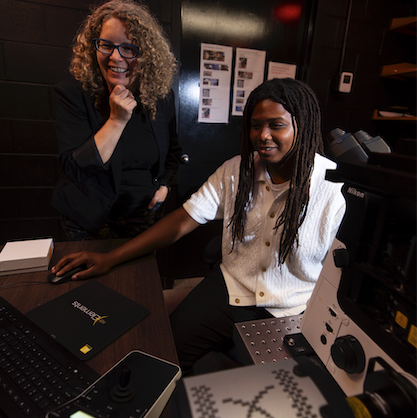
In 2014, Gilad Barnea, then an assistant professor, applied for an award from a brand new brain science seed funding program. Barnea was close to making a breakthrough on a project he’d been obsessed with since his days as a postdoc: developing a tool for mapping brain circuits at the molecular level. The funding, Barnea said, came at “exactly the right time,” giving him the resources he needed to build trans-Tango, a circuit-tracing kit used in nearly 300 research projects worldwide.
The Zimmerman Innovation Awards in Brain Science–the source of Barnea's early support–drive discovery for the Robert J. and Nancy D. Carney Institute. Now 10 years in, the awards have made a significant return on investment. Brain science investigators who received a total of $4.9 million in innovation award funding have earned $166 million in external funding. The awards have forged powerful science partnerships that have accelerated discovery in many fields including neurodegeneration, neuroengineering and psychology.
“There’s nothing more thrilling to a research scientist than the chance to test their most creative ideas and theories,” said Diane Lipscombe, Reliance Dhirubhai Ambani Director of the Carney Institute. “The Zimmerman fund speeds discovery by allowing brain scientists to take the road less traveled. This is the starting point for scientific breakthroughs.”
Through the awards, Carney invests up to $100,000 per project for one year, renewable for a second year on a competitive basis. A committee evaluates applications for their potential to advance science and benefit society, focusing on projects too early-stage to be appropriate for the National Institutes of Health (NIH) or other government or foundation funding.
The awards so far have supported 45 research projects, directed by 55 principal investigators across Brown, and seeded high-impact science. Barnea’s trans-Tango circuit-tracing tool, for example, has garnered more than 50 times the sum in external funding that Carney invested and is being used in top neuroscience labs.
Innovation awards have supported exciting new research projects involving scientists at all career levels, from trainees to senior faculty members. There’s an additional boost of $32,000 to support projects involving at least one junior investigator.
Theresa Desrochers, now the Rosenberg Family Assistant Professor of Brain Science with appointments in the Departments of Neuroscience and Psychiatry and Human Behavior, first applied for an award when she was a postdoctoral researcher, submitting the proposal with her then-advisor David Badre, now chair of the Department of Cognitive and Psychological Sciences, and David Sheinberg, a professor in the Department of Neuroscience. The award allowed Desrochers to test a key neuroimaging technique that was new to Brown. She was hired into a tenure-track position and can trace much of her current research funding, including three federal grants, to that innovation award project.
In 2021, the awards program was expanded to fund an additional pool of research projects focused on Alzheimer’s disease and related dementias. To date, Carney has invested over $800,000 in 10 research projects specifically in this area. Bess Frost, the Salame-Feraud Director of the Center for Alzheimer's Disease Research, appreciates the support.
“Carney has found a way to de-risk high-reward science,” Frost said, “and applying that approach to Alzheimer’s disease is going to pay off in big ways.”

Over 10 years, the awards have fueled important discoveries across a wide spectrum of brain science topics, from autism to artificial intelligence. Major projects include:
- Gene regulatory networks in circuit development and plasticity: Back-to-back awards in 2018 and 2019 created a brain science supergroup: behavioral neurogeneticist Karla Kaun, synapse and gene-editing expert Kate O’Connor-Giles and genome expert Erica Larschan. The trio investigate how hundreds of genes and the instructions they contain work to form and modify synapses, the places where neurons connect and communicate. The group was awarded two highly competitive NIH grants to conduct this work, and more applications are in the works. So far, their discoveries have increased understanding of the underpinnings of addiction and certain intellectual disabilities.
- Biomarkers to guide treatment of hydrocephalus: A 2019 innovation award to neural circuit and behavior specialist Alexander Fleischmann, computer vision expert Thomas Serre, neurosurgeon Petra Klinge and biomedical entrepreneur Maria Grazia Ruocco led to a breakthrough in treating normal pressure hydrocephalus, a brain disorder that causes 5% to 10% of all dementia cases. The team have formed a company, Adelle Diagnostics, to test the biomarkers they discovered in clinical trials.
- Measuring neural activity with light: Thanks to a 2020 innovation award, protein engineer Ahmed Abdelfattah teamed up with neurobiologist Carlos Aizenman to develop a new type of voltage sensor to map electrical communication between brain cells. That initial research gave Abdelfattah important preliminary data for future funding applications and inspired him to continue to experiment in voltage imaging. He now has external funding for his voltage sensor work from the NIH and other sources that is more than 30 times the initial investment amount from the innovation award.
While the innovation awards don’t explicitly require that research projects are collaborative, Carney Director of Research Strategy John Davenport says that over half of all projects involve multiple labs, and that even the projects funding single labs represent the collaborative efforts of an investigator and their trainees.
“The number and variety of collaborations says something about the strength of the Carney community,” Davenport said. “The awards also showcase the interesting and important ideas our faculty come up with. And they keep coming. We’ve seen more applications for these awards this year than ever before.”